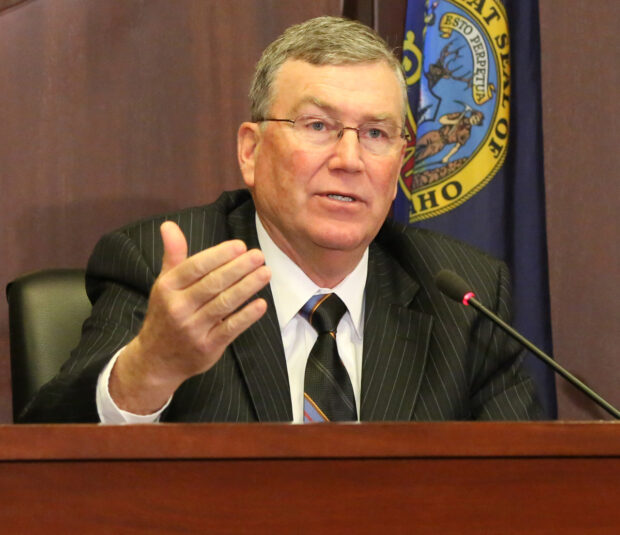The House needed just 28 minutes Monday morning to approve all seven K-12 public school budget bills. The bills passed comfortably and without any debate.
Taken together, the seven budgets would increase state general fund spending on public schools by 6.3 percent next year, or slightly more than $100 million.
The budgets direct nearly $1.7 billion in general fund spending.
By far the largest chunk of new spending is a nearly $62 million plan to fund a third consecutive year of raises under the Legislature’s career ladder salary law.
Budget highlights include:
- $61.9 million for new raises for teachers.
- $6.9 million to pay for 3 percent raises for administrators and classified staff members who are not affected by the career ladder.
- $5 million to increase classroom technology.
- $5 million for additional IT staffing.
- $4.25 million for additional teacher professional development.
- $2 million to increase college and career counseling.
- Increasing per-classroom spending levels from $25,696 to $26,748.
Notably, the Joint Finance-Appropriations Committee’s budgets go against the health care budget proposal that Gov. Butch Otter advocated. Otter used his State of the State address to call for setting aside $15 million in a separate spending “line item” to help school districts offset employees’ health care insurance costs.
Instead, JFAC and the House backed a more general plan to increase per-classroom spending levels, known as discretionary spending. Under that plan, $15,506 of the $26,748 is available for school leaders to truly spend at their discretion. The remaining $11,242 is designed to help offset benefit costs. If districts spend less than $11,242 for health care, they may use the remaining balance at their discretion, Rep. Wendy Horman told lawmakers.
Horman and other lawmakers came up with the $11,242 figure by computing a weighted average of districts’ health care costs.
“For the first time ever, we are specifically recognizing that health care costs are going up,” said Horman, R-Idaho Falls.
So far, the public school budget package has enjoyed widespread support. Just three representatives — Rep. Mike Moyle, R-Star, Rep. Greg Chaney, R-Caldwell, and Rep. Jeff Thompson, R-Idaho Falls — voted against the central services portion of the budget, which funds WiFi Internet services and supports reading tests and literacy initiatives.
The other budgets passed with two or fewer no votes among the 70 representatives.
The biggest budget of the group — the budget for teachers’ programs, which includes career ladder funding — passed 68-2. Reps. Vito Barbieri, R-Dalton Gardens, and Steven Harris, R-Meridian, cast the no votes. The school administration budget also passed 68-2, with the dissenting votes coming from Barbieri and Moyle. Harris and Thompson also voted against the operations division budget, while Barbieri was the only representative to vote against the children’s programs budget.
Two budgets, to fund facilities and the Idaho School for the Deaf and Blind, passed unanimously.

House Speaker Scott Bedke praised Horman and other representatives who took the lead on the school budgets. He said they used the five-year plan outlined in Otter’s Task Force for Improving Education as a blueprint, which is why the budgets received so much support.
“What you’re seeing is the Legislature keeping its commitment to the five-year plan,” Bedke said.
Overall, he said the House passed the school budgets “in grand style” making today “a good day.”
Although enrollment growth caught some state officials off-guard, Bedke said lawmakers were able to incorporate funding for 100 unexpected additional classrooms into “a very responsible budget, not only for taxpayers, but for the education stakeholders.”
Horman said she came to work Monday prepared to answer tough questions about the school budgets, but was pleased to encounter no real opposition.
“I was really happy there was almost unanimous support for those budgets,” she said.
Horman said the budget process made a difference. JFAC’s new budget hearing format places a greater emphasis on budget nuts and bolts. The first year’s work from the Legislature’s public school funding formula interim committee and continued adherence to the Task Force recommendations led to a transparent budget process that the vast majority of legislators could stand behind.
“That must be why the questions were answered before we got to this point,” Horman said.
By contrast, several smaller state agency budgets sparked more debate Monday, and ran into more resistance. For example, the House passed a $24.7 million budget for the attorney general’s office, on a 40-30 vote.
Public school spending accounts for about 48.8 percent of state general fund spending next year – by far the state’s largest expense.
In order for the budgets to take effect, they still must clear the Senate and avoid Otter’s veto stamp.
Senate OKs bad weather leeway
On the first day of spring, the Senate approved a bill precipitated by the winter of 2017.
House Bill 242 would allow schools to seek weather-related waivers from the state’s minimum classroom hour law. A state or county disaster designation would trigger the waiver, which the State Board of Education would issue.
The winter of 2017 — and rampant school closures — has left districts struggling to make up for lost classroom hours. Without some leeway, schools will be forced to stay open into the summer.
“This is not just a couple of snow days,” said Sen. Abby Lee, R-Fruitland.
Sen. Jim Patrick argued that the schools should extend the instructional year, if that’s what it takes to make up the time.
“I really thought the idea was to educate the students,” said Patrick, R-Twin Falls.
Patrick’s colleagues were not persuaded, and they passed HB 242 on a 34-1 vote. The bill now goes to Otter.
Idaho Education News reporter Kevin Richert contributed to this report.
